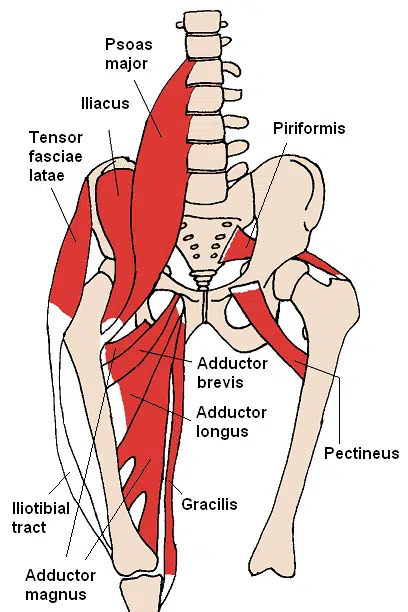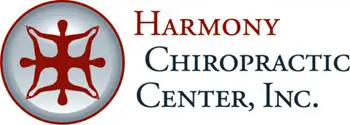A groin pull or strain is an injury when the muscles located on the inner aspect of your thigh get overstretched or torn. This group of muscles is the adductor muscles that run from the inner side of your pelvis to the inner part of your thigh bone, and which pull your legs toward each other.

What Causes Groin Strains?
The groin can be strained when one or more of the muscles are:
- Overstretched
- Overworked
- Directly injured by a blow
You can strain any of these muscles during running, kicking, or jumping, as well as when you push or pull heavy objects, or when you fall.
Straining the groin is common in running activities that require cutting like football, basketball and soccer. Groin pulls are also fairly common in ice hockey as they account for 10 to 13% of all hockey injuries. Previous injuries can predispose people to groin strains. Some have compared the injuries to the groin to shin splints in the way that the muscles are overstretched and overworked
One factor that plays a major role in those that end up suffering groin strains is weakness of the adductor muscles. Multiple studies show that the strength of your adductor muscles is an independent predictor for groin injury for multiple different soccer players. The ratio of the strength of hip adduction to abduction is a risk factor for groin injury. It was determined that if your groin is 20% weaker than your hip abductors, you have a greater risk of injury.
How to Prevent Groin Strain
As with other pulled muscles, groin strains can be avoided by:
- Keeping your adductor muscles strong and flexible through regular strengthening and stretching exercises.
- Gradually increasing your exercise duration and intensity.
- Getting enough rest to avoid overtraining and fatigue, which can increase the risk of injury.
What are the Symptoms of a Groin Strain?

Individuals who experience groin strain often describe a popping or snapping sensation during the injury. Other signs and symptoms may include:
- Pain and tenderness in the inner thigh
- Swelling and bruising in the area
- Pain and muscle spasm, especially when you move your leg toward the midline
- Leg weakness
- Limping
What’s the Difference between Groin Strain and Sports Hernia?
Hernias and groin strains tend to have similar types of pain but there are some important differences. Both have pain associated with the groin and both may involve bruising in the groin or abdomen area.
Groin strains are more common in the younger individuals who are actively participating in sports. There is often a component of moving the hip laterally when the injury occurs. Stretching the muscle likely causes pain.
Hernias are when a weakness develops in the abdominal wall which may allow a portion of fatty tissue or a body organ to protrude through the weakness. The presence of a lump indicates you may be suffering from a hernia. Sports hernias are less common in children, but if you’re older, you’re more likely to experience groin pain due to a hernia. Hernias tend to produce pain in the groin on coughing. Also, performing a sit-up while actively squeezing the knees together against resistance tends to increase pain beyond just squeezing the knees. Chronic recurring “groin strains” also tend to more likely be a result of an undetected hernia.
If you are not sure, it makes sense to get an evaluation by your primary care provider or another trained healthcare provider.
Groin Strain: What to Do at Home?
With rest and appropriate treatment, most groin strains heal completely and will not cause lasting problems.
- Rest and protect your injured groin. Avoid any activity that exacerbates the pain.
- Apply an ice pack on the painful area for about 10 to 20 minutes every 1 to 2 hours
- Carefully move the injured area in a pain free range-of-motion.
- When the swelling has subsided, usually in about 2 to 3 days, you can apply a warm compress for 10 to 20 minutes.
- Perform adductor stretching by moving your affected leg outward up to the limit of pain and holding the stretch for 30 seconds before going back to the starting position. Caution is advised as stretches should not be attempted for at least 1-week post-injury.
- Nonsteroidal anti-inflammatory drugs or NSAIDs will help with pain and swelling, but these should be taken as per your doctor’s advice.
Treatment for Groin Strains
When it comes to treatment for a groin strain, there are a few options, but remember that getting the right diagnosis is the most important issue. You need to know the correct problem to apply the right treatment.
Interestingly, chiropractic adjustments to a portion of the back called the Sacroiliac joint have been reported to provide immediate relief of pain in a significant number of individuals suffering from a groin strain. Massage therapy is an obvious choice for the treatment of groin strains, but the sensitive location of the injury can make discussion about and treatment of the injury a little awkward for some massage therapists and their clients.

Graston Technique is an excellent treatment option to help individuals recover after a groin strain. Athletes with groin strains tend to return-to-play about 4 ½ weeks sooner when they receive manual therapy (like Graston Technique) in addition to stretching instructions and a return to running program.
Cold Laser Therapy or Photobiomodulation Therapy is another treatment option that can reduce the recovery time associated with healing from a groin strain. Cold laser produces profound proven biological effects on tissue including relief of pain, acceleration of the healing process, increased cell proliferation, promoting tissue regeneration, preventing cell death and anti-inflammatory activity. It is dose-dependent and can be designed to decrease pain (inhibitory dose) while increasing tissue repair. Photobiomodulation therapy is an option that holds few side effects and almost negligible risks. Numerous studies have shown photobiomodulation therapy is an effective treatment for painful conditions.
Kinesio Tape can also be beneficial as it can be used to reduce any initial bruising associated with muscle tears or it can be applied to support the involved muscle and reduce pain. It is not a universal cure for the injury, but it can help people to be temporarily more comfortable while recovering.
And finally, one of the most important aspects of recovering from a groin strain is using appropriate rehabilitation exercises to strengthen the involved muscles. As stated multiple times in this article, weakness in the involved adductor group tends to be a factor in initial injuries and re-injuries. Strengthening the adductor muscles is one of the keys to helping prevent future injuries. Care must be taken as to not try to progress too quickly while the area is already injured and trying to recover. Initial steps need to be taken to decrease pain and inflammation in the area while building tolerance to movement and corrective exercise. It is wise to try to build harmony between the muscles associated with the hip including a proper balance of the ability to abduct and abduct the hip as well as flex and extend the hip. Adductors and gluteal muscles tend to be weaker and need to be strengthened. In some cases, weakness in muscles like the gluteus medius can lead to pain in the groin since the muscles have become too tight in relation to each other.
